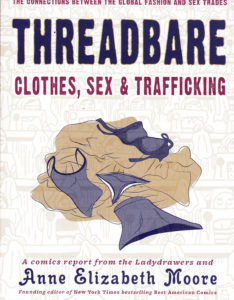Threadbare: Clothes, Sex & Trafficking
There’s a long list of things I would do if I was a rich man, but high up on that list would be funding comics journalism, or graphic journalism. Whatever it is that Joe Sacco established roughly 20 years ago, anyway. This is a rare occasion where I’ll cite Wikipedia, but they list Emi Gennis, Jen Sorenson, Dar Archer, Matt Bors and Josh Neufeld (among others), and I’m constantly surprised that this isn’t more of an established thing by now. As Anne makes clear in the introduction, that’s mostly because funding is incredibly difficult to come by, especially with a project like this one that covers years of interviews, travel and multiple artists. I’m only going to briefly summarize these sections, as they’re chock full of details (and footnotes after the fact), so the only way to really do them justice is to read them yourself. The title gives you the basics of what’s covered in here, and it’s broken down into four sections. First up is The United States, which deals with fast fashion, the real life of a model, clothing stores, thrift stores, warehouses full of clothes to be recycled, and the trade agreements that “govern” this whole mess. The story of the model (and her description of the ones that were best able to adjust to the environment and the ones who weren’t) is heartbreaking, as is the general waste and pollution caused by the thrift industry (and how little of the profits actually make it to charities). The second section deals with Austria and the history of textiles and fashion, including stories from people who have lived their whole lives in the industry and are seeing it start to vanish due to competition from the larger clothing chains. The third section tells the story of Cambodia, the working conditions and wages of the factories, how that sometimes turns into sex work and how it can cycle back into garment work due to a lack of other options. The fourth section is The World, and it’s probably going to be the most surprising chapter for people who only have a passing knowledge of the sex trade industry and trafficking. The shocking bits (to me, anyway) detail how sex trafficking (slavery, basically) is treated the same in the US as voluntary sex work, and how funding for getting rid of sex slavery often gets tied up in ridiculous moral rules that come from the hyper-religious types. Fighting these moralistic scolds is incredibly difficult because they’re successfully blurred the lines for years, and money that could be more effectively put into housing and counseling for actual victims instead goes into advertising to convince people that their children will be sold into slavery if they leave their parents’ sight for a few minutes. It does conclude on a hopeful note, with some practical advice on how to change things for all of the various problems they’ve documented, but it’s daunting to say the least. Even if you think you’re an expert on this subject I guarantee that you’ll find new information in here, and the comics are drawn by the some of the best artists working today. If you know any millionaires please tell them to throw some money at people who are looking to do this type of graphic journalism, because the world needs more of it. $13.95




 Posted by Kevin
Posted by Kevin 




